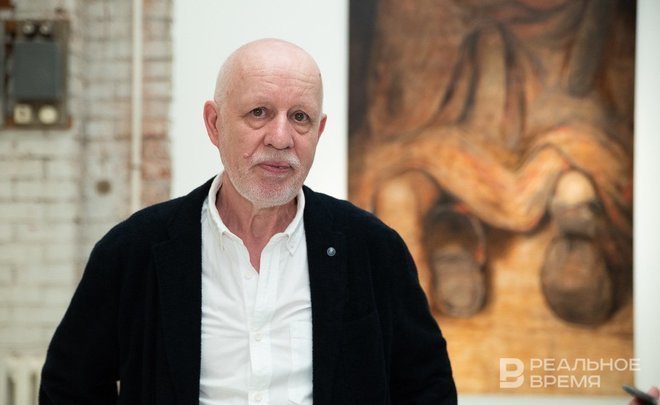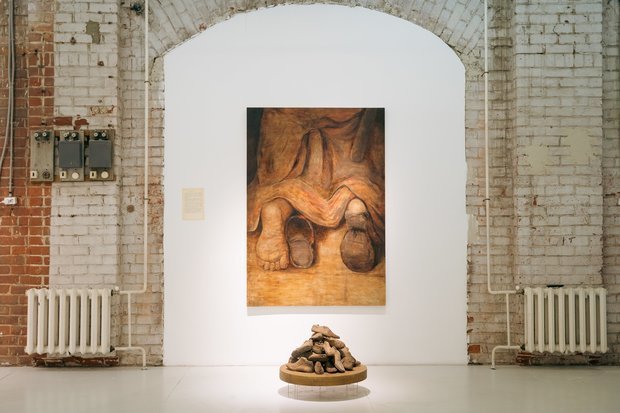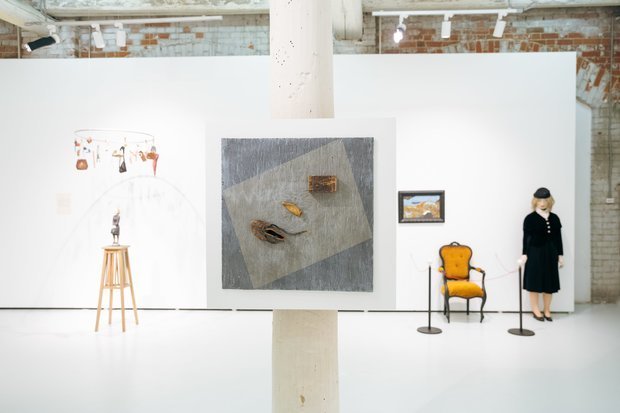‘I love the world of numbers’: Ilgizar Khasanov’s picturesque ‘mathematics’
The artist's thirteenth solo exhibition Natural Numbers about the stages of human life

Ilgizar Khasanov's personal exhibition Natural Numbers is being held at the Smena Centre for Contemporary Culture. Realnoe Vremya met with the artist, as well as with the curator of the exhibition, Yaroslav Alyoshin, and talked about the coincidence of numbers and signs in a person's life.
As part of the Summer Book Festival of Smena on June 17-18, guided mediation tours of the Natural Numbers exhibition will be held.
A large bright room, four white pillars — this space contained the symmetry and cycle of human life as artist Ilgizar Khasanov saw it. The same platform has become not only a limitation, but a creative task for the curator of the exhibition, Yaroslav Aleshin. There is already a geometry of the building and a small space for the exhibition. You can't build a new architecture with this reality. “This project was literally born out of limitations," says Aleshin.
Eleven works of Ilgizar Khasanov were combined into history. In the history of human life: from the first steps in society — a nursery kindergarten group — to a sign of memory, the only tangible object that reminded of the existence of a person who already passed away.
Yaroslav Aleshin came up with the idea of works arrangement from the interrelations between the exhibits: “Installation is a complicated thing. It can be concentrated in one place, in one space, at one point. The installation can be open and work as a serial object. The main thing is to understand how objects should interact with each other.”
What is exhibition? An exhibition is like a speech: in it, words should be formed into sentences, sentences — into paragraphs, paragraphs — into a chapter, and chapters — into a book.
“Here it was important for us to understand how to fit 11 works into a limited space with wooden columns, and even so as to tell a complete story with their help. I think we did it. We saw formal coincidences — the number of elements in the works, the number of elements outside the framework. This is the recalculation of numbers, from which abstract thinking begins. We have mirror symmetry. Among the array of work, we found two installations that have the same number of elements — five each. Further, reflecting on this, I came to the idea that I see a completely consistent and developing plot in each of them. Five numbers, five organised zones," Aleshin explained.

If the curator of the exhibition has a more functional view of numbers, then Ilgizar Khasanov considers the five steps in a person's life from the point of view of the philosophy of mathematics:
“Mathematics can explain any event and any physical action. Numbers help to restore order and understand cause-and-effect relationships, patterns, and system of interactions. One number interacts with another. Although my math was not good, but I love this world — the world of numbers. I think they are very graphic. Sometimes they suggest plots and lines, I always try to rely on them. Even in the works presented at the exhibition, there is something mathematical, arithmetic.”
Natural Numbers tell the story of a certain subject. Each stage of its life is compared with a certain subject, and then a relationship develops between a person and an object. At first, a person prevails in them, and the object is exclusively of official significance. With the overgrowth of social obligations, there are more and more objects, and a person gets lost among them until he or she turns into a sign of memory. The movement between the subject to the memory sign and back and the tension between the object and the person is an important field of meaning in which the exhibition functions.
But where one story ends, another begins. The features of the hall suggest a circular viewing, the viewer in any case makes a circle and loops the story. As a result, it turned out to be not just two parallel installations, but a holistic story in which the end coincides with the beginning, and the beginning — with the end. “History in youth is perceived as unidirectional, as a vector to the horizon. But with age, history becomes like a set of cycles: day after day, year after year, epoch after epoch," says Yaroslav Aleshin.

Having integrated human life into the exhibition space, Ilgizar Khasanov is sure that contemporary art is also integrated into human life:
“Modern life and contemporary art are highly integrated into each other today.
I believe that the more art there is in life, the more humane, more subtle we are and the more we move towards the life we dream of. Beautiful can be seen in everything. Art is valuable for this.”
Can art save the world?
No. Then we would have been saved long ago. An animal differs from a human in that all thought processes are suppressed in the direction of instinct. A human being can reason, think. But at the same time, he can invent and create terrible things that are unthinkable for the animal world. Art does not save the world, but creates barriers and boundaries. When you realise that you are able to think and create parallel worlds in the form of cinema and visual concepts, then art has no function, it is not needed. It is so unnecessary that it is impossible without it.
Speaking of the creepy and wonderful things that a person can do. Leni Riefenstahl is a person who combines genius and villainy. Should we separate the artist from his actions or not?
This is a difficult situation. It seems to me that she saw this structure precisely from the artist's side, from the side of rhythms and beauty, not from the side of ideology. But we all consist not only of thoughts, but also of actions. Her actions are very complicated. From the side of art, everything is great, everything is high, but from the side of ethics, I would say, it's no good. I would not cooperate with such a regime. She, apparently, was carried away by culture and did not notice where she ended up. Or maybe she was just very cynical.
An artist is allowed a little more in this life. Because he is a pioneer, an innovator. He expands the boundaries of what is possible in any field: in theatre, cinema, fine art, especially in modern art. If you start forbidding him, then you are forbidding life itself in all its manifestations. It seems to me that ethics is the responsibility of the author, he himself must understand which social field he will enter and which he will not. For example, I don't even have to turn on internal censor. By my nature, I cannot enter the field where I will cause someone moral suffering.
Ekaterina Petrova is the author of the telegram channel Poppy Seed Muffins (Булочки с маком) and the founder of the first online subscription book club Makulatura.